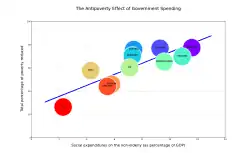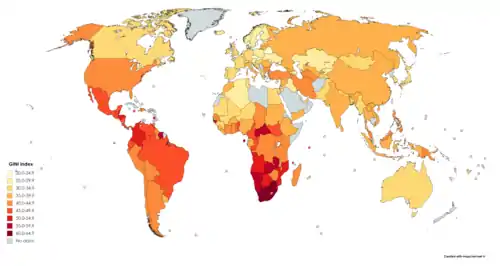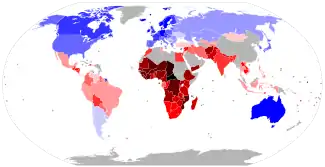Welfare's effect on poverty
The effects of social welfare on poverty has been studied.[1]

Studies have shown that in welfare states, poverty decreases after countries adopt welfare programs.[2] Empirical evidence suggests that taxes and transfers considerably reduce poverty in most countries whose welfare states commonly constitute at least a fifth of GDP.[3][4][5][6][7][8] In 2013, the Organisation for Economic Co-operation and Development asserted that welfare spending is vital in reducing the ever-expanding global wealth gap.[9]
Table of effect


Timothy Smeeding used data from the Luxembourg Income Study to determine the effectiveness of anti-poverty and welfare programs on poverty reduction. The data for all the countries was from the year 2000 with the exception of the United Kingdom and the Netherlands for which the data was from 1999.[1]
| Country | Social expenditures on non-elderly[1][Notes 1] (as percentage of GDP) | Total percent of poverty reduced[1] |
|---|---|---|
| 2.3 | 26.4 | |
| 9.6 | 65.2 | |
| 11.6 | 77.4 | |
| 7.3 | 70.5 | |
| 5.8 | 46.0 | |
| 10.9 | 69.7 | |
| 7.1 | 60.1 | |
| 9.3 | 76.9 | |
| 7.4 | 75.8 | |
| 4.3 | 57.7 | |
| 5.5 | 44.1 | |
| Average | 7.4 | 60.9 |
Table of poverty levels pre- and post-welfare


Two studies compare countries internationally before and after implementing social welfare programs. Using data from the Luxembourg Income Study, Bradley et al. and Lane Kenworthy measure the poverty rates both in relative terms (poverty defined by the respective governments) and absolute terms (poverty defined by 40% of United States median income), respectively. Kenworthy's study also adjusts for economic performance and shows that the economy made no significant difference in uplifting people out of poverty.
The studies look at the different countries from 1960 to 1991 (Kenworthy) and from 1970 to 1997 (Bradley et al.). Both these periods are roughly when major welfare programs were implemented such as the War on Poverty in the United States. The results of both studies show that poverty has been significantly reduced during the periods when major welfare programs were created.
| Country | Absolute poverty rate (1960–1991) (threshold set at 40% of United States median household income)[2] | Relative poverty rate
(1970–1997)[4] | ||
|---|---|---|---|---|
| Pre-welfare | Post-welfare | Pre-welfare | Post-welfare | |
| 23.7 | 5.8 | 14.8 | 4.8 | |
| 9.2 | 1.7 | 12.4 | 4.0 | |
| 22.1 | 7.3 | 18.5 | 11.5 | |
| 11.9 | 3.7 | 12.4 | 3.1 | |
| 26.4 | 5.9 | 17.4 | 4.8 | |
| 15.2 | 4.3 | 9.7 | 5.1 | |
| 12.5 | 3.8 | 10.9 | 9.1 | |
| 22.5 | 6.5 | 17.1 | 11.9 | |
| 36.1 | 9.8 | 21.8 | 6.1 | |
| 26.8 | 6.0 | 19.5 | 4.1 | |
| 23.3 | 11.9 | 16.2 | 9.2 | |
| 16.8 | 8.7 | 16.4 | 8.2 | |
| 21.0 | 11.7 | 17.2 | 15.1 | |
| 30.7 | 14.3 | 19.7 | 9.1 | |
Notes
- This includes cash and near-cash spending (such as TANF and food stamps) and spending for public housing. It excludes healthcare and education spending.
References
- Smeeding, Timothy (2006). Poor People in Rich Nations: The United States in Comparative Perspective. Table 4, "The Antipoverty Effect of Government Spending: Percent of All Persons Poor". Journal of Economic Perspectives—Volume 20, Number 1—Winter 2006 —Pp. 69 –90.
- Kenworthy, L. (1999). Do social-welfare policies reduce poverty? A cross-national assessment. Social Forces, 77(3), 1119–39.
- Woolf, Steven; Aaron, Laudon. "U.S. Health in International Perspective". National Research Council and Institute of Medicine. pp. 171–72. Retrieved April 8, 2013.
- Bradley, D.; Huber, E.; Moller, S.; Nielson, F.; Stephens, J. D. (2003). "Determinants of Relative Poverty in Advanced Capitalist Democracies". American Sociological Review. 68 (3): 22–51. JSTOR 3088901.
- Kevin Drum (26 September 2013). We Can Reduce Poverty If We Want To. We Just Have To Want To. Mother Jones. Retrieved 28 September 2013.
- Gould, Elise and Wething, Hilary (24 July 2012). "U.S. poverty rates higher, safety net weaker than in peer countries." Economic Policy Institute. Retrieved 26 July 2013.
- Zachary A. Goldfarb (9 December 2013). Study: U.S. poverty rate decreased over past half-century thanks to safety-net programs. The Washington Post. Retrieved 15 January 2015.
- Kenworthy, Lane (February 2014). America's Social Democratic Future. Foreign Affairs. Retrieved 8 February 2014. See also: Kenworthy, Lane (2014). Social Democratic America. Oxford University Press. ISBN 0199322511
- Wealth Gap Widens In Rich Countries As Austerity Threatens To Worsen Inequality: OECD. The Huffington Post. Retrieved 26 July 2013.
- "GINI index (World Bank estimate) | Data". data.worldbank.org. Retrieved 2020-07-23.